Tracking Airborne Pollution with Environmental Magnetism in A Medium-Sized African City
Abstract
1. Introduction
2. Materials and Methods
2.1. Study Area
2.2. Sampling
2.3. Magnetic Measurements and Microscopic Observations
3. Results
3.1. Magnetic Content
3.2. Magnetic Characterization
3.3. SEM Observation
4. Discussion
4.1. Anthropogenic Pollution and Traffic-Related Particles
4.2. Neem Bark and Leaves as Complementary Biocollectors
5. Conclusions
Author Contributions
Funding
Institutional Review Board Statement
Informed Consent Statement
Acknowledgments
Conflicts of Interest
References
- Marié, D.C.; Chaparro, M.A.E.; Gogorza, C.S.G.; Navas, A.; Sinito, A.M. Vehicle-derived emissions and pollution on the road autovia 2 investigated by rock-magnetic parameters: A case study from Argentina. Stud. Geophys. Geod. 2010, 54, 135–152. [Google Scholar] [CrossRef]
- Dockery, D.W.; Pope, C.A. Acute Respiratory Effects of Particulate Air Pollution. Annu. Rev. Public Health 1994, 15, 107–132. [Google Scholar] [CrossRef]
- Englert, N. Fine particles and human health—A review of epidemiological studies. Toxicol. Lett. 2004, 149, 235–242. [Google Scholar] [CrossRef] [PubMed]
- Kelly, F.J.; Fussell, J.C. Air pollution and public health: Emerging hazards and improved understanding of risk. Environ. Geochem. Health 2015, 37, 631–649. [Google Scholar] [CrossRef]
- Burnett, R.; Chen, H.; Szyszkowicz, M.; Fann, N.; Hubbell, B.; Pope, C.A.; Apte, J.S.; Brauer, M.; Cohen, A.; Weichenthal, S.; et al. Global estimates of mortality associated with longterm exposure to outdoor fine particulate matter. Proc. Natl. Acad. Sci. USA 2018, 115, 9592–9597. [Google Scholar] [CrossRef] [PubMed]
- Pascal, M.; Corso, M.; Chanel, O.; Declercq, C.; Badaloni, C.; Cesaroni, G.; Henschel, S.; Meister, K.; Haluza, D.; Martin-Olmedo, P.; et al. Assessing the public health impacts of urban air pollution in 25 European cities: Results of the Aphekom project. Sci. Total Environ. 2013, 449, 390–400. [Google Scholar] [CrossRef] [PubMed]
- World Health Organisation. Ambient Air Pollution: A Global Assessment of Exposure and Burden of Disease; World Health Organisation: Geneva, Switzerland, 2016. [Google Scholar]
- Owili, P.O.; Lien, W.H.; Muga, M.A.; Lin, T.H. The associations between types of ambient PM2.5 and under-five and maternal mortality in Africa. Int. J. Environ. Res. Public Health 2017, 14, 359. [Google Scholar] [CrossRef] [PubMed]
- Liousse, C.; Assamoi, E.; Criqui, P.; Granier, C.; Rosset, R. Explosive growth in African combustion emissions from 2005 to 2030. Environ. Res. Lett. 2014, 9, 035003. [Google Scholar] [CrossRef]
- Djossou, J.; Léon, J.F.; Barthélemy Akpo, A.; Liousse, C.; Yoboué, V.; Bedou, M.; Bodjrenou, M.; Chiron, C.; Galy-Lacaux, C.; Gardrat, E.; et al. Mass concentration, optical depth and carbon composition of particulate matter in the major southern West African cities of Cotonou (Benin) and Abidjan (Côte d’Ivoire). Atmos. Chem. Phys. 2018, 18, 6275–6291. [Google Scholar] [CrossRef]
- Ntziachristos, L.; Giechaskiel, B.; Pistikopoulos, P.; Fysikas, E.; Samaras, Z. Particle Emissions Characteristics of Different On-Road Vehicles. J. Fuels Lubr. 2003, 112, 1568–1578. [Google Scholar]
- Keita, S.; Liousse, C.; Yoboú, V.; Dominutti, P.; Guinot, B.; Assamoi, E.M.; Borbon, A.; Haslett, S.L.; Bouvier, L.; Colomb, A.; et al. Particle and VOC emission factor measurements for anthropogenic sources in West Africa. Atmos. Chem. Phys. 2018. [Google Scholar] [CrossRef]
- Xu, H.; Léon, J.F.; Liousse, C.; Guinot, B.; Yoboué, V.; Akpo, A.B.; Adon, J.; Ho, K.F.; Ho, S.S.H.; Li, L.; et al. Personal exposure to PM2.5 emitted from typical anthropogenic sources in southern West Africa: Chemical characteristics and associated health risks. Atmos. Chem. Phys. 2019, 19, 6637–6657. [Google Scholar] [CrossRef]
- Knippertz, P.; Evans, M.J.; Field, P.R.; Fink, A.H.; Liousse, C.; Marsham, J.H. The possible role of local air pollution in climate change in West Africa. Nat. Clim. Chang. 2015, 5, 815–822. [Google Scholar] [CrossRef]
- Léon, J.F.; Barthélémy Akpo, A.; Bedou, M.; Djossou, J.; Bodjrenou, M.; Yoboué, V.; Liousse, C. PM2.5surface concentrations in southern West African urban areas based on sun photometer and satellite observations. Atmos. Chem. Phys. 2021, 21, 1815–1834. [Google Scholar] [CrossRef]
- Hofman, J.; Maher, B.A.; Muxworthy, A.R.; Wuyts, K.; Castanheiro, A.; Samson, R. Biomagnetic Monitoring of Atmospheric Pollution: A Review of Magnetic Signatures from Biological Sensors. Environ. Sci. Technol. 2017, 51, 6648–6664. [Google Scholar] [CrossRef]
- Leite, A.d.S.; Léon, J.-F.; Macouin, M.; Rousse, S.; da Trindade, R.I.F.; Proietti, A.; Drigo, L.; Antonio, P.Y.J.; Akpo, A.B.; Yoboué, V.; et al. PM2.5 Magnetic Properties in Relation to Urban Combustion Sources in Southern West Africa. Atmosphere 2021, 12, 496. [Google Scholar] [CrossRef]
- Saragnese, F.; Lanci, L.; Lanza, R. Nanometric-sized atmospheric particulate studied by magnetic analyses. Atmos. Environ. 2011, 45, 450–459. [Google Scholar] [CrossRef]
- Sagnotti, L.; Taddeucci, J.; Winkler, A.; Cavallo, A. Compositional, morphological, and hysteresis characterization of magnetic airborne particulate matter in Rome, Italy. Geochem. Geophys. Geosyst. 2009, 10. [Google Scholar] [CrossRef]
- Vezzola, L.C.; Muttoni, G.; Merlini, M.; Rotiroti, N.; Pagliardini, L.; Hirt, A.M.; Pelfini, M. Investigating distribution patterns of airborne magnetic grains trapped in tree barks in Milan, Italy: Insights for pollution mitigation strategies. Geophys. J. Int. 2017, 210, 989–1000. [Google Scholar] [CrossRef][Green Version]
- Winkler, A.; Caricchi, C.; Guidotti, M.; Owczarek, M.; Macrì, P.; Nazzari, M.; Amoroso, A.; Di Giosa, A.; Listrani, S. Combined magnetic, chemical and morphoscopic analyses on lichens from a complex anthropic context in Rome, Italy. Sci. Total Environ. 2019, 690, 1355–1368. [Google Scholar] [CrossRef]
- Dunlop, D.; Özdemir, Ö. Rock Magnetism: Fundamentals and Frontiers; Cambridge University Press: Cambridge, UK, 1997. [Google Scholar] [CrossRef]
- Chaparro, M.A.E.; Chaparro, M.A.E.; Castañeda-Miranda, A.G.; Marié, D.C.; Gargiulo, J.D.; Lavornia, J.M.; Natal, M.; Böhnel, H.N. Fine air pollution particles trapped by street tree barks: In situ magnetic biomonitoring. Environ. Pollut. 2020, 266, 115229. [Google Scholar] [CrossRef]
- Maher, B.A. Rain and dust: Magnetic records of climate and pollution. Elements 2009, 5, 229–234. [Google Scholar] [CrossRef]
- Jordanova, D.; Petrov, P.; Hoffmann, V.; Gocht, T.; Panaiotu, C.; Tsacheva, T.; Jordanova, N. Magnetic Signature of Different Vegetation Species in Polluted Environment. Stud. Geophys. Geod. 2010, 54, 417–442. [Google Scholar] [CrossRef]
- Rai, P.K.; Chutia, B.M.; Patil, S.K. Monitoring of spatial variations of particulate matter (PM) pollution through bio-magnetic aspects of roadside plant leaves in an Indo-Burma hot spot region. Urban For. Urban Green. 2014, 13, 761–770. [Google Scholar] [CrossRef]
- Reyes, B.A.; Mejía, V.; Goguitchaichvili, A.; Escobar, J.; Bayona, G.; Bautista, F.; Morales, J.C.; Ihl, T.J. Reconnaissance environmental magnetic study of urban soils, dust and leaves from Bogotá, Colombia. Stud. Geophys. Geod. 2013, 57, 741–754. [Google Scholar] [CrossRef]
- Szönyi, M.; Sagnotti, L.; Hirt, A.M. A refined biomonitoring study of airborne particulate matter pollution in Rome, with magnetic measurements on Quercus Ilex tree leaves. Geophys. J. Int. 2008, 173, 127–141. [Google Scholar] [CrossRef]
- Castañeda-Miranda, A.G.; Böhnel, H.N.; Molina-Garza, R.S.; Chaparro, M.A.E. Magnetic evaluation of TSP-filters for air quality monitoring. Atmos. Environ. 2014, 96, 163–174. [Google Scholar] [CrossRef]
- Tsozué, D.; Nzeukou, A.; Azinwi, P. Genesis and classification of soils developed on gabbro in the high reliefs of Maroua region, North Cameroon 2017. Eurasian J. Soil Sci. 2017, 6, 168–177. [Google Scholar]
- Ogbuewu, I.P.; Odoemenam, Y.U.; Obikaonu, H.O.; Opara, M.N.; Emenalom, O.O.; Uchegbu, M.C.; Okoli, I.C.; Esonu, B.O.; Iloeje, M.U. The growing importance of neem (Azadirachta indica A. Juss) in agriculture, industry, medicine and environment: A review. Res. J. Med. Plant 2011, 5, 230–245. [Google Scholar] [CrossRef]
- Forim, M.R.; Fernandes, D.S.M.F.; Fernandes, J.B.; Vieira, P.C. Processo de Obtenção de Nanopartículas Biopoliméricas Contendo Óleo e Extratos de Azadirachta Indica a. Juss (neem). Nanopartículas Biopoliméricas e Micropartículas em pó. BR102013021210-5 B1, 23 January 2014. [Google Scholar]
- King, J.W.; Channell, J.E.T. Sedimentary Magnetism, Environmental Magnetism, and Magnetostratigraphy. Rev. Geophys. 1991, 29, 358–370. [Google Scholar] [CrossRef]
- Maxbauer, D.P.; Feinberg, J.M.; Fox, D.L. MAX UnMix: A web application for unmixing magnetic coercivity distributions. Comput. Geosci. 2016, 95, 140–145. [Google Scholar] [CrossRef]
- Kruiver, P.P.; Dekkers, M.J.; Heslop, D. Quantification of magnetic coercivity components by the analysis of acquisition curves of isothermal remanent magnetisation. Earth Planet. Sci. Lett. 2001, 189, 269–276. [Google Scholar] [CrossRef]
- Heslop, D.; Dekkers, M.J.; Kruiver, P.P.; van Oorschot, I.H.M. Analysis of isothermal remanent magnetization acquisition curves using the expectation-maximization algorithm. Geophys. J. Int. 2002, 148, 58–64. [Google Scholar] [CrossRef]
- Egli, R. Characterization of individual rock magnetic components by analysis of remanence curves. 2. Fundamental properties of coercivity distributions. Phys. Chem. Earth 2004, 29, 851–867. [Google Scholar] [CrossRef]
- Rochette, P.; Fillion, G. Field and temperature behavior of remanence in synthetic goethite: Paleomagnetic implications. Geophys. Res. Lett. 1989, 16, 851–854. [Google Scholar] [CrossRef]
- Abrajevitch, A.; Van der Voo, R.; Rea, D.K. Variations in relative abundances of goethite and hematite in Bengal Fan sediments: Climatic vs. diagenetic signals. Mar. Geol. 2009, 267, 191–206. [Google Scholar] [CrossRef]
- Itambi, A.C.; Von Dobeneck, T.; Dekkers, M.J.; Frederichs, T. Magnetic mineral inventory of equatorial Atlantic Ocean marine sediments off Senegal-glacial and interglacial contrast. Geophys. J. Int. 2010, 183, 163–177. [Google Scholar] [CrossRef]
- Rochette, P.; Mathé, P.E.; Esteban, L.; Rakoto, H.; Bouchez, J.L.; Liu, Q.; Torrent, J. Non-saturation of the defect moment of goethite and fine-grained hematite up to 57 Teslas. Geophys. Res. Lett. 2005, 32. [Google Scholar] [CrossRef]
- Frank, U.; Nowaczyk, N.R. Mineral magnetic properties of artificial samples systematically mixed from haematite and magnetite. Geophys. J. Int. 2008, 175, 449–461. [Google Scholar] [CrossRef]
- Spiteri, C.; Kalinski, V.; Rösler, W.; Hoffmann, V.; Appel, E. Magnetic screening of a pollution hotspot in the Lausitz area, Eastern Germany: Correlation analysis between magnetic proxies and heavy metal contamination in soils. Environ. Geol. 2005, 49, 1–9. [Google Scholar] [CrossRef]
- Lu, S.G.; Bai, S.Q.; Xue, Q.F. Magnetic properties as indicators of heavy metals pollution in urban topsoils: A case study from the city of Luoyang, China. Geophys. J. Int. 2007, 171, 568–580. [Google Scholar] [CrossRef]
- Gautam, P.; Blaha, U.; Appel, E.; Ghanashyam, N. Environmental magnetic approach towards the quantification of pollution in Kathmandu urban area, Nepal. Phys. Chem. Earth 2004, 29, 973–984. [Google Scholar] [CrossRef]
- Winkler, A.; Contardo, T.; Vannini, A.; Sorbo, S.; Basile, A.; Loppi, S. Magnetic emissions from brake wear are the major source of airborne particulate matter bioaccumulated by lichens exposed in Milan (Italy). Appl. Sci. 2020, 10, 2073. [Google Scholar] [CrossRef]
- Grousset, F.E.; Biscaye, P.E. Tracing dust sources and transport patterns using Sr, Nd and Pb isotopes. Chem. Geol. 2005, 222, 149–167. [Google Scholar] [CrossRef]
- Hassan, S.K.; Khoder, M.I. Chemical characteristics of atmospheric PM2.5 loads during air pollution episodes in Giza, Egypt. Atmos. Environ. 2017, 150, 346–355. [Google Scholar] [CrossRef]
- Tang, Y.; Han, G. Characteristics of major elements and heavy metals in atmospheric dust in Beijing, China. J. Geochemical Explor. 2017, 176, 114–119. [Google Scholar] [CrossRef]
- Formenti, P.; Caquineau, S.; Chevaillier, S.; Klaver, A.; Desboeufs, K.; Rajot, J.L.; Belin, S.; Briois, V. Dominance of goethite over hematite in iron oxides of mineral dust from Western Africa: Quantitative partitioning by X-ray absorption spectroscopy. J. Geophys. Res. Atmos. 2014, 119, 12740–12754. [Google Scholar] [CrossRef]
- Lyons, R.; Oldfield, F.; Williams, E. Mineral magnetic properties of surface soils and sands across four North African transects and links to climatic gradients. Geochem. Geophys. Geosystems 2010, 8. [Google Scholar] [CrossRef]
- Larrasoaña, J.C.; Pey, J.; Zhao, X.; Heslop, D.; Mochales, T.; Mata, P.; Beamud, E.; Reyes, J.; Cerro, J.C.; Pérez, N.; et al. Environmental magnetic fingerprinting of anthropogenic and natural atmospheric deposition over southwestern Europe. Atmos. Environ. 2021, 261, 118568. [Google Scholar] [CrossRef]
- Ohta, A.; Tsuno, H.; Kagi, H.; Kanai, Y.; Nomura, M.; Zhang, R.; Terashima, S.; Imai, N. Chemical compositions and XANES speciations of Fe, Mn and Zn from aerosols collected in China and Japan during dust events. Geochem. J. 2006, 40, 363–376. [Google Scholar] [CrossRef][Green Version]
- Prietzel, J.; Thieme, J.; Eusterhues, K.; Eichert, D. Iron speciation in soils and soil aggregates by synchrotron-based X-ray microspectroscopy (XANES, μ-XANES). Eur. J. Soil Sci. 2007, 58, 1027–1041. [Google Scholar] [CrossRef]
- Larrasoaña, J.C.; Roberts, A.P.; Liu, Q.; Lyons, R.; Oldfield, F.; Rohling, E.J.; Heslop, D. Source-to-sink magnetic properties of NE saharan dust in Eastern Mediterranean marine sediments: Review and paleoenvironmental implications. Front. Earth Sci. 2015, 3, 1–15. [Google Scholar] [CrossRef]
- Rijkeboer, R.; Bremmers, D.; Samaras, Z.; Ntziachristos, L. Particulate matter regulation for two-stroke two wheelers: Necessity or haphazard legislation? Atmos. Environ. 2005, 39, 2483–2490. [Google Scholar] [CrossRef]
- Etissa, D.; Mohr, M.; Schreiber, D.; Buffat, P.A. Investigation of particles emitted from modern 2-stroke scooters. Atmos. Environ. 2008, 42, 183–195. [Google Scholar] [CrossRef]
- Zuurbier, M.; Willems, J.; Schaap, I.; van der Zee, S.; Hoek, G. The contribution of moped emissions to ultrafine and fine particle concentrations on bike lanes. Sci. Total Environ. 2019, 686, 191–198. [Google Scholar] [CrossRef] [PubMed]
- Leong, S.T.; Muttamara, S.; Laortanakul, P. Influence of benzene emission from motorcycle on Bangkok air quality. Atmos. Environ. 2002. [Google Scholar] [CrossRef]
- Kabir, E.; Kim, K.H.; Yoon, H.O. Trace metal contents in barbeque (BBQ) charcoal products. J. Hazard. Mater. 2011, 185, 1418–1424. [Google Scholar] [CrossRef] [PubMed]
- Smeda, A.; Zyrnicki, W. Application of sequential extraction and the ICP-AES method for study of the partitioning of metals in fly ashes. Microchem. J. 2002, 72, 9–16. [Google Scholar] [CrossRef]
- Ries, F.J.; Marshall, J.D.; Brauer, M. Intake fraction of urban wood smoke. Environ. Sci. Technol. 2009, 43, 4701–4706. [Google Scholar] [CrossRef] [PubMed]
- McClean, R.G.; Kean, W.F. Contributions of wood ash magnetism to archaeomagnetic properties of fire pits and hearths. Earth Planet. Sci. Lett. 1993, 119, 387–394. [Google Scholar] [CrossRef]
- Chaparro, M.A.E.; Lavornia, J.M.; Chaparro, M.A.E.; Sinito, A.M. Biomonitors of urban air pollution: Magnetic studies and SEM observations of corticolous foliose and microfoliose lichens and their suitability for magnetic monitoring. Environ. Pollut. 2013, 172, 61–69. [Google Scholar] [CrossRef]
- Suzuki, K. Characterisation of airborne particulates and associated trace metals deposited on tree bark by ICP-OES, ICP-MS, SEM-EDX and laser ablation ICP-MS. Atmos. Environ. 2006, 40, 2626–2634. [Google Scholar] [CrossRef]
- Kardel, F.; Wuyts, K.; Maher, B.A.; Hansard, R.; Samson, R. Leaf saturation isothermal remanent magnetization (SIRM) as a proxy for particulate matter monitoring: Inter-species differences and in-season variation. Atmos. Environ. 2011, 45, 5164–5171. [Google Scholar] [CrossRef]
- Mitchell, R.; Maher, B.A.; Kinnersley, R. Rates of particulate pollution deposition onto leaf surfaces: Temporal and inter-species magnetic analyses. Environ. Pollut. 2010, 158, 1472–1478. [Google Scholar] [CrossRef] [PubMed]
- Rodríguez-Germade, I.; Mohamed, K.J.; Rey, D.; Rubio, B.; García, Á. The influence of weather and climate on the reliability of magnetic properties of tree leaves as proxies for air pollution monitoring. Sci. Total Environ. 2014, 468–469, 892–902. [Google Scholar] [CrossRef]
- Muhammad, S.; Wuyts, K.; Samson, R. Atmospheric net particle accumulation on 96 plant species with contrasting morphological and anatomical leaf characteristics in a common garden experiment. Atmos. Environ. 2019, 202, 328–344. [Google Scholar] [CrossRef]
- Urbat, M.; Lehndorff, E.; Schwark, L. Biomonitoring of air quality in the Cologne conurbation using pine needles as a passive sampler—Part I: Magnetic properties. Atmos. Environ. 2004, 38, 3781–3792. [Google Scholar] [CrossRef]
- Lehndorff, E.; Urbat, M.; Schwark, L. Accumulation histories of magnetic particles on pine needles as function of air quality. Atmos. Environ. 2006, 40, 7082–7096. [Google Scholar] [CrossRef]
- De la Paz, D.; Borge, R.; Vedrenne, M.; Lumbreras, J.; Amato, F.; Karanasiou, A.; Boldo, E.; Moreno, T. Implementation of road dust resuspension in air quality simulations of particulate matter in Madrid (Spain). Front. Environ. Sci. 2015, 3. [Google Scholar] [CrossRef]
- Matzka, J.; Maher, B.A. Magnetic biomonitoring of roadside tree leaves: Identification of spatial and temporal variations in vehicle-derived particulates. Atmos. Environ. 1999, 33, 4565–4569. [Google Scholar] [CrossRef]
- McIntosh, G.; Gómez-Paccard, M.; Osete, M.L. The magnetic properties of particles deposited on Platanus x hispanica leaves in Madrid, Spain, and their temporal and spatial variations. Sci. Total Environ. 2007, 382, 135–146. [Google Scholar] [CrossRef]
- Mitchell, R.; Maher, B.A. Evaluation and application of biomagnetic monitoring of traffic-derived particulate pollution. Atmos. Environ. 2009, 43, 2095–2103. [Google Scholar] [CrossRef]
- Prajapati, S.K.; Pandey, S.K.; Tripathi, B.D. Monitoring of vehicles derived particulates using magnetic properties of leaves. Environ. Monit. Assess. 2006, 120, 169–175. [Google Scholar] [CrossRef]
- Moreno, E.; Sagnotti, L.; Dinarès-Turell, J.; Winkler, A.; Cascella, A. Biomonitoring of traffic air pollution in Rome using magnetic properties of tree leaves. Atmos. Environ. 2003, 37, 2967–2977. [Google Scholar] [CrossRef]
- Abu-Allaban, M.; Gillies, J.A.; Gertler, A.W.; Clayton, R.; Proffitt, D. Tailpipe, resuspended road dust, and brake-wear emission factors from on-road vehicles. Atmos. Environ. 2003, 37, 5283–5293. [Google Scholar] [CrossRef]
- Meza-Figueroa, D.; González-Grijalva, B.; Del Río-Salas, R.; Coimbra, R.; Ochoa-Landin, L.; Moreno-Rodríguez, V. Traffic signatures in suspended dust at pedestrian levels in semiarid zones: Implications for human exposure. Atmos. Environ. 2016, 138, 4–14. [Google Scholar] [CrossRef]
- Xu, X.; Yu, X.; Mo, L.; Xu, Y.; Bao, L.; Lun, X. Atmospheric particulate matter accumulation on trees: A comparison of boles, branches and leaves. J. Clean. Prod. 2019, 226, 349–356. [Google Scholar] [CrossRef]
- Paoli, L.; Winkler, A.; Guttová, A.; Sagnotti, L.; Grassi, A.; Lackovičová, A.; Senko, D.; Loppi, S. Magnetic properties and element concentrations in lichens exposed to airborne pollutants released during cement production. Environ. Sci. Pollut. Res. Int. 2017, 24, 12063–12080. [Google Scholar] [CrossRef]
- Gautam, P.; Blaha, U.; Appel, E. Magnetic susceptibility of dust-loaded leaves as a proxy of traffic-related heavy metal pollution in Kathmandu city, Nepal. Atmos. Environ. 2005, 39, 2201–2211. [Google Scholar] [CrossRef]
- Norouzi, S.; Khademi, H.; Cano, A.F.; Acosta, J.A. Biomagnetic monitoring of heavy metals contamination in deposited atmospheric dust, a case study from Isfahan, Iran. J. Environ. Manag. 2016, 173, 55–64. [Google Scholar] [CrossRef]
- Sant’Ovaia, H.; Lacerda, M.J.; Gomes, C. Particle pollution—An environmental magnetism study using biocollectors located in northern Portugal. Atmos. Environ. 2012, 61, 340–349. [Google Scholar] [CrossRef]
- Leng, X.; Qian, X.; Yang, M.; Wang, C.; Li, H.; Wang, J. Leaf magnetic properties as a method for predicting heavy metal concentrations in PM2.5 using support vector machine: A case study in Nanjing, China. Environ. Pollut. 2018, 242, 922–930. [Google Scholar] [CrossRef] [PubMed]
- Doumbia, E.H.T.; Liousse, C.; Keita, S.; Granier, L.; Granier, C.; Elvidge, C.D.; Elguindi, N.; Law, K. Flaring emissions in Africa: Distribution, evolution and comparison with current inventories. Atmos. Environ. 2019, 199, 423–434. [Google Scholar] [CrossRef]
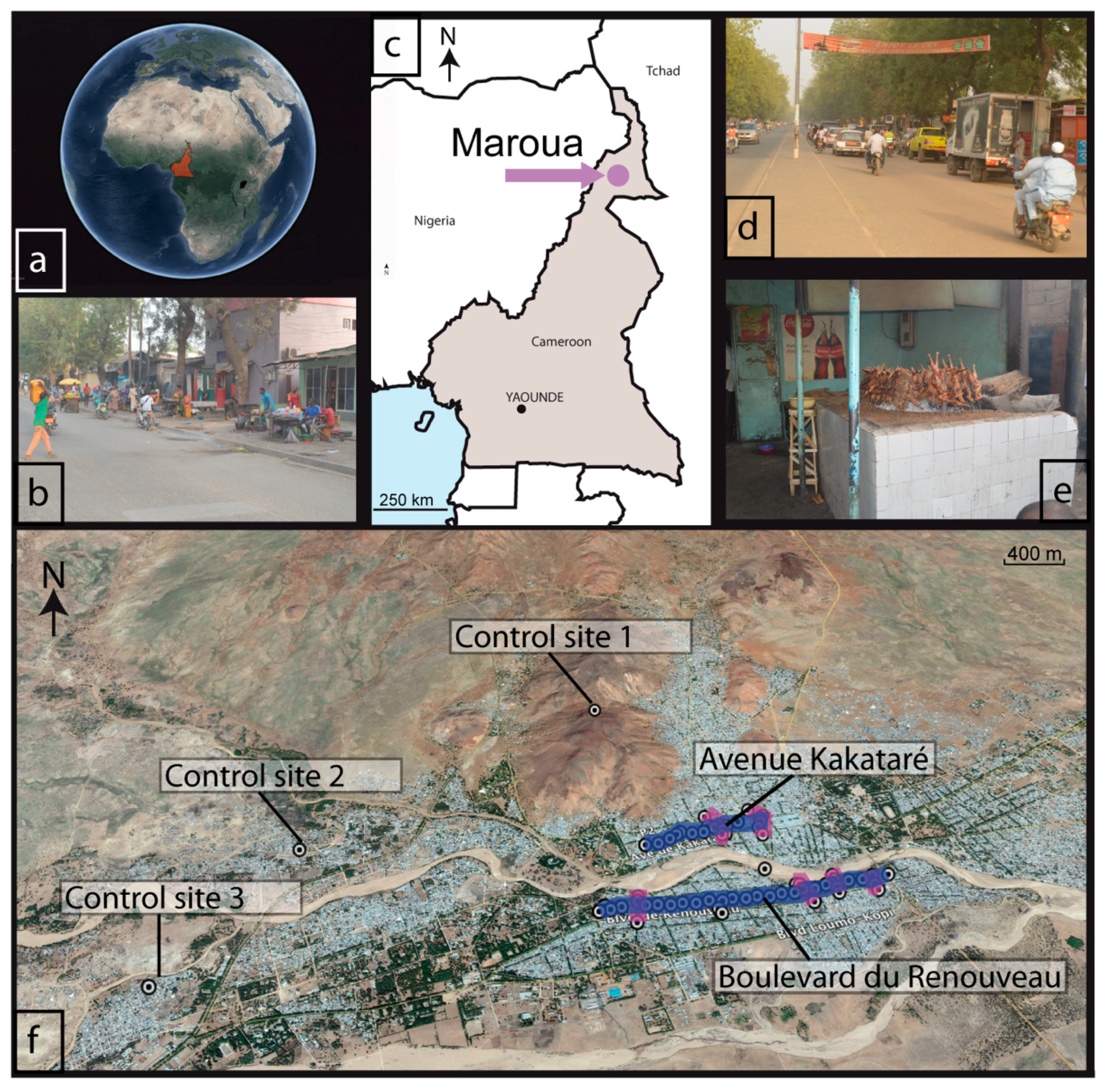
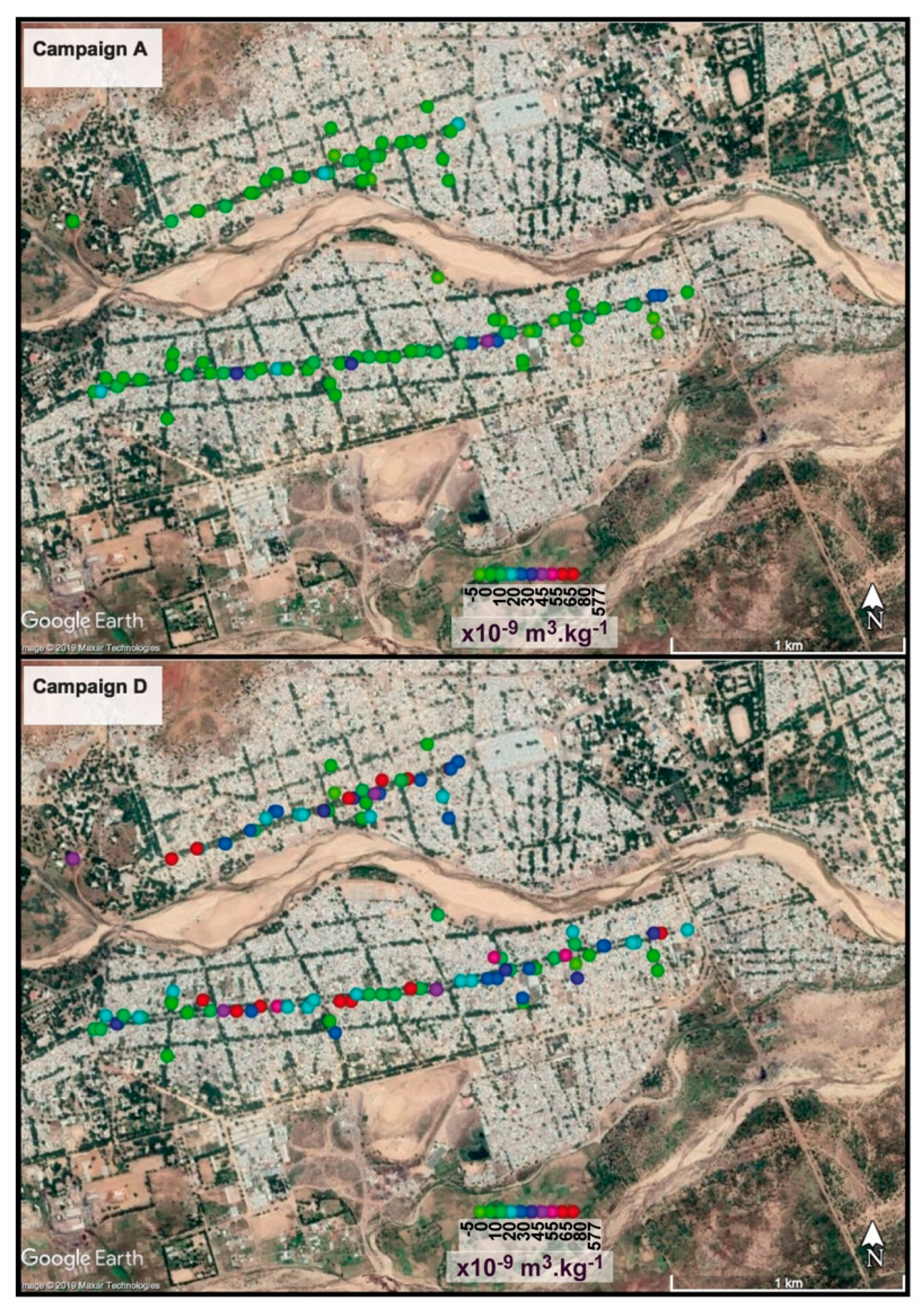
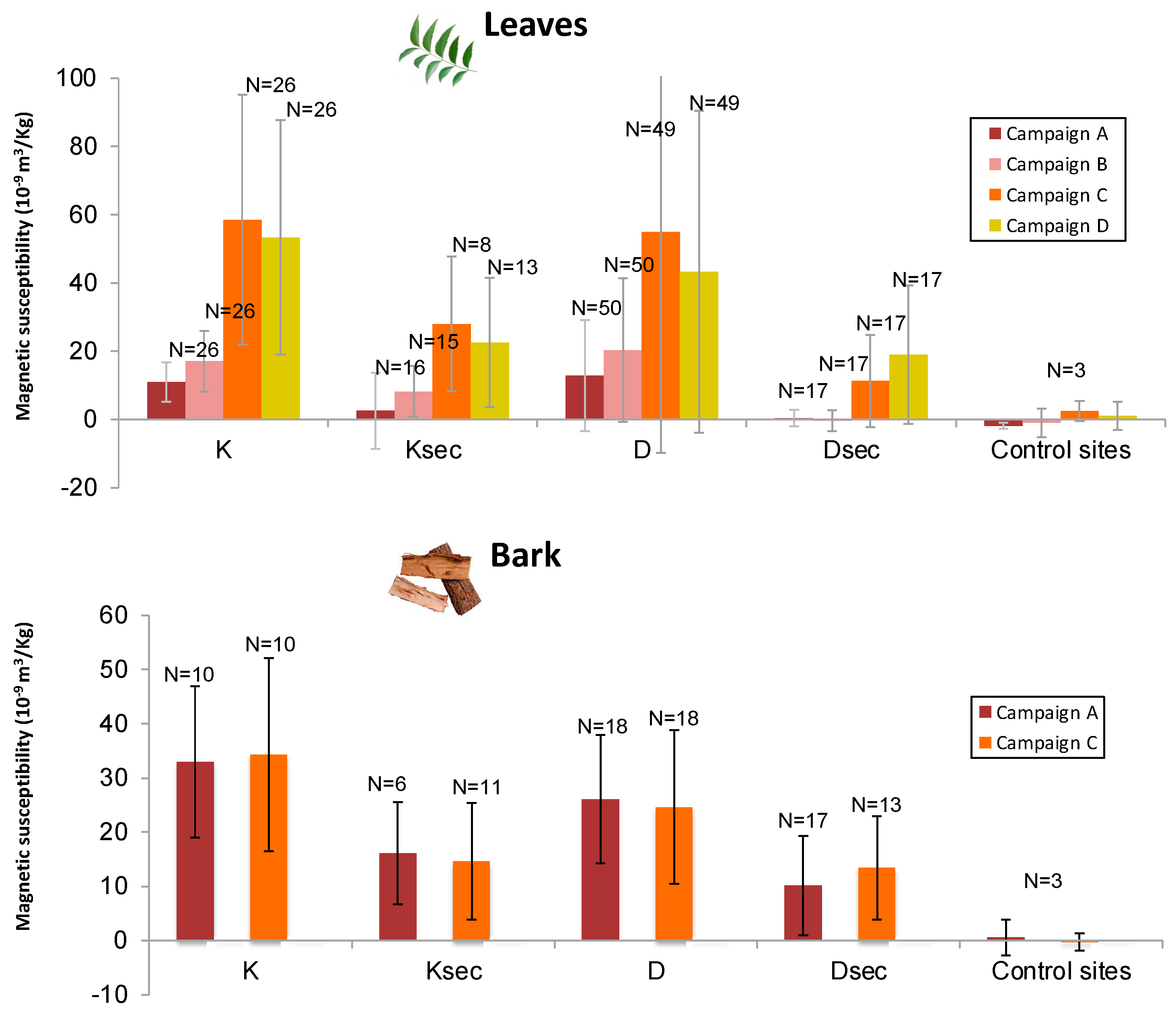
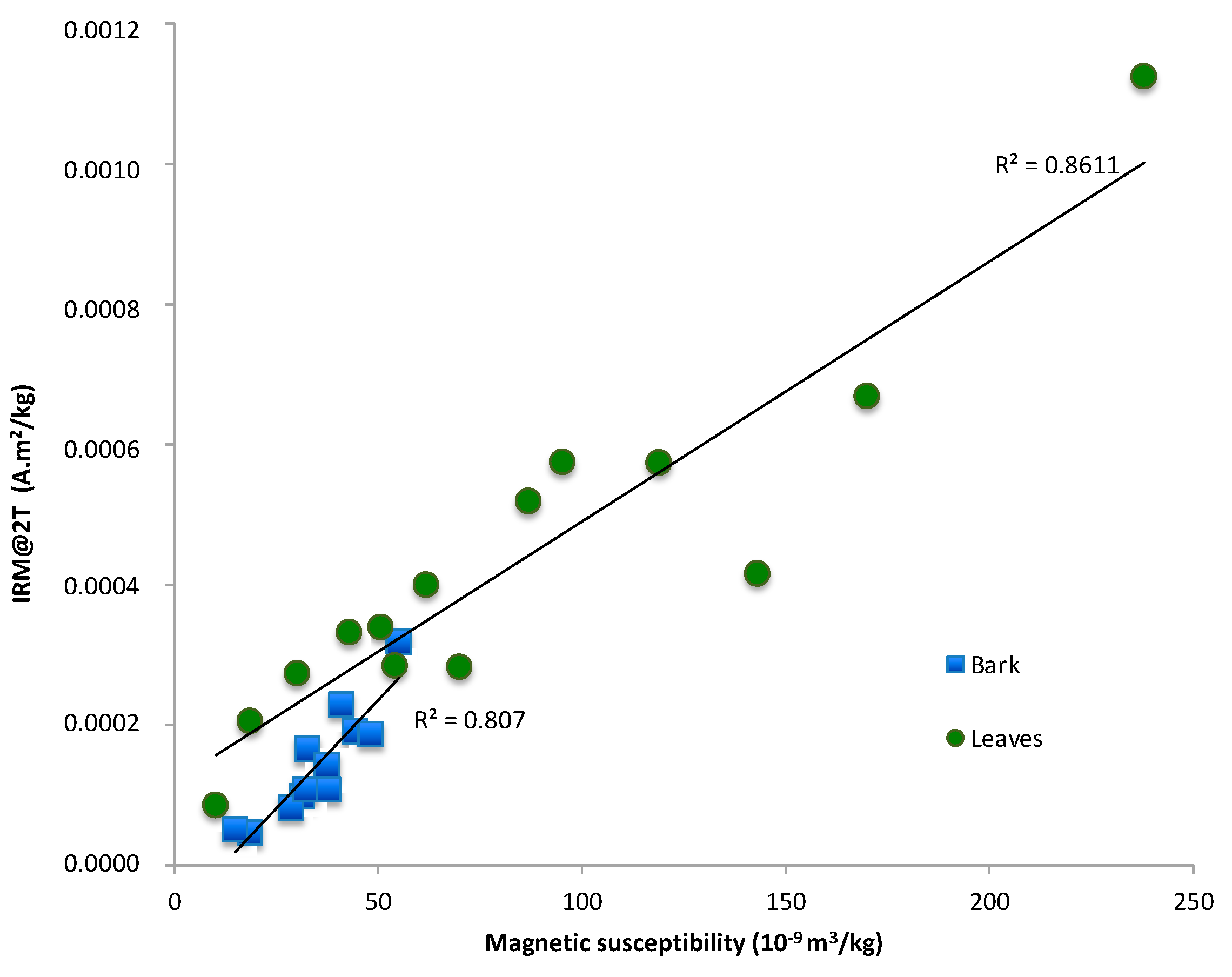
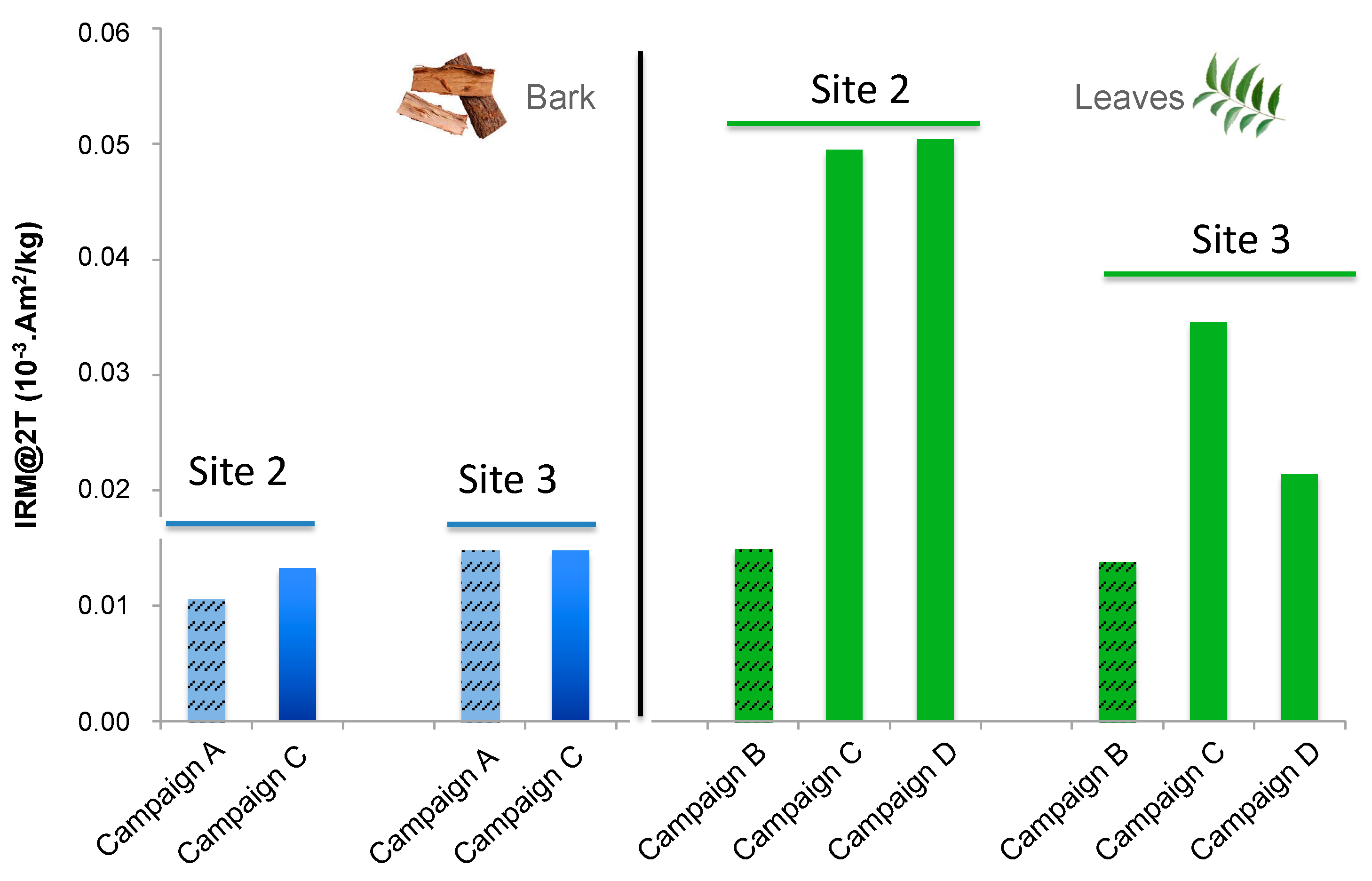
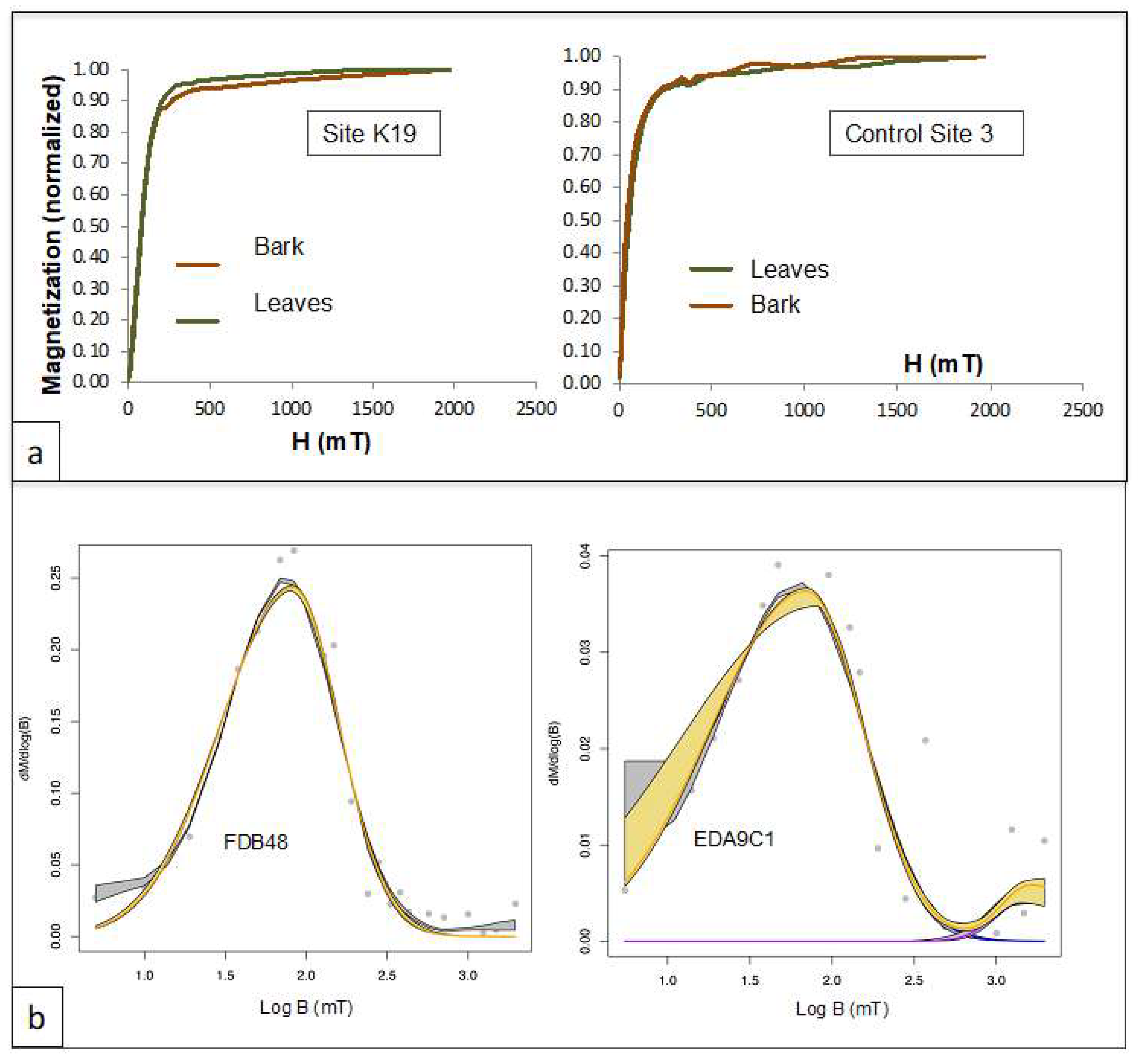
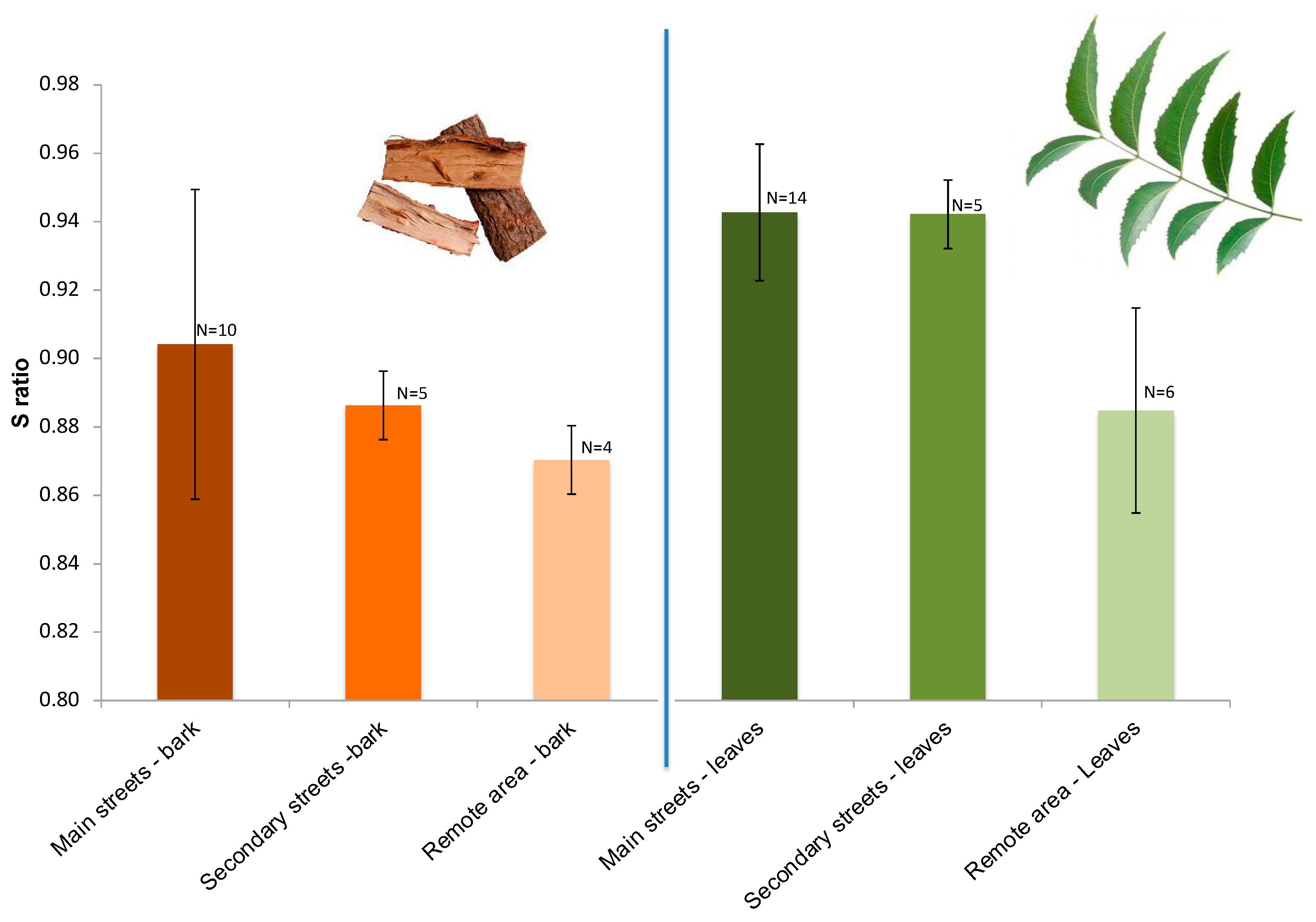
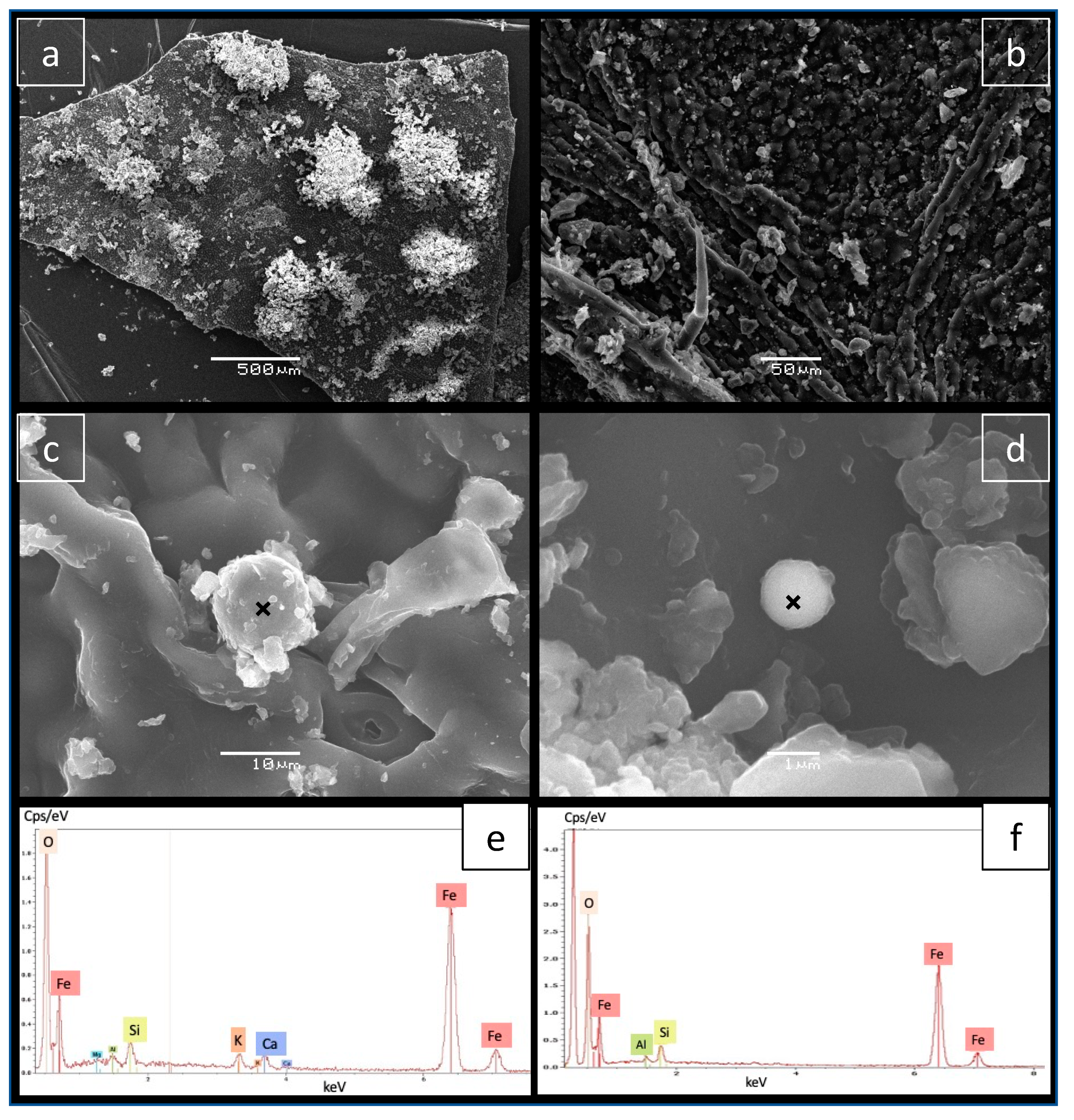
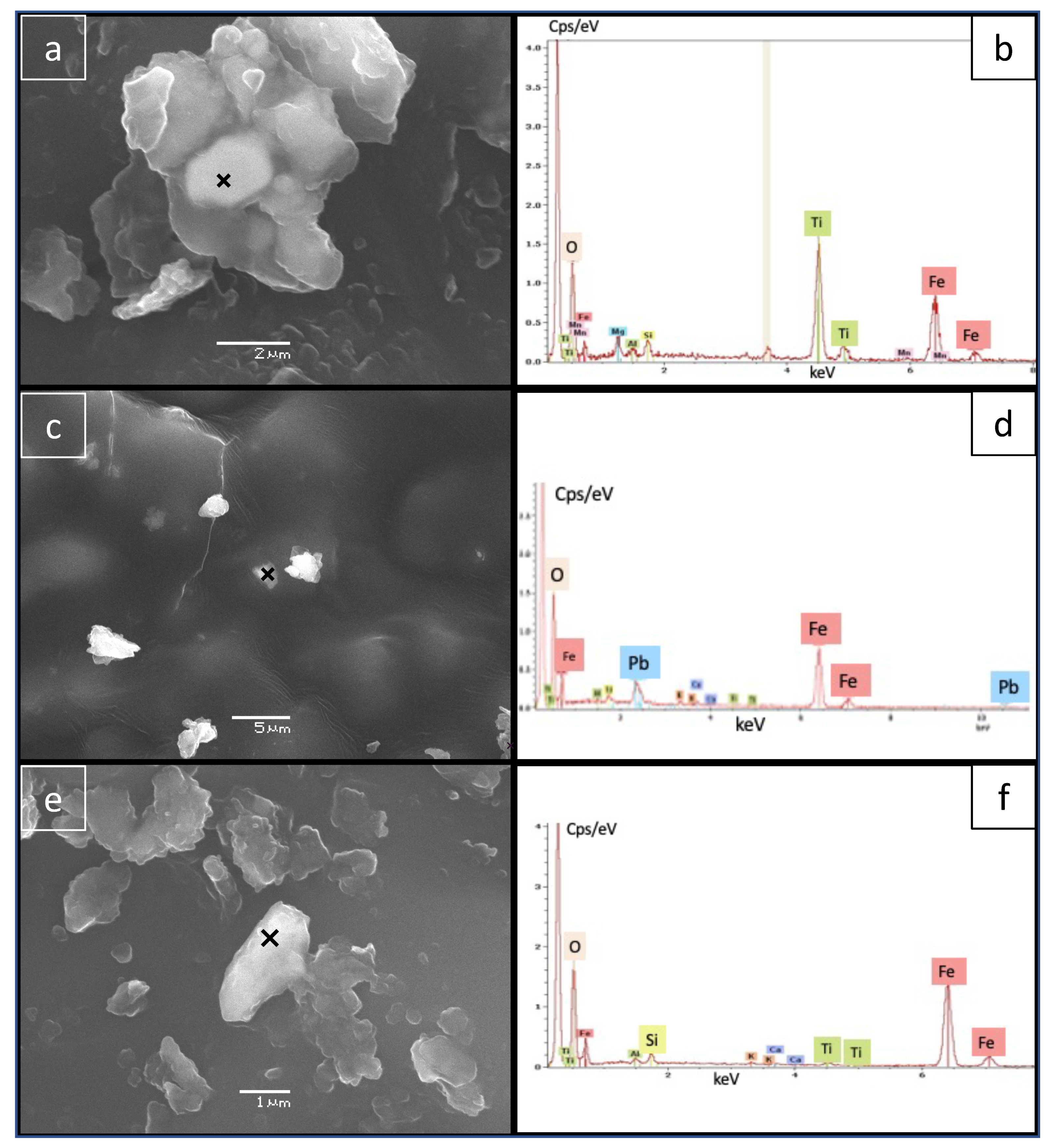
| Country | City | City Population | Env. | Species | Species Common Name | Type of leaf | Sus_Min | Sus_Max | Sus_Mean | Comments | Ref. |
|---|---|---|---|---|---|---|---|---|---|---|---|
| Nepal | Kathmandu | 1,000,000 | urban | Cupressus corneyana | Cypress | evergreen | 1.00 × 10−10 | 5.40 × 10−7 | - | - | Gautam et al., 2005 [45] |
| Nepal | Kathmandu | 1,000,000 | urban | Grevillea robusta | Silky Oak | evergreen | 2.75 × 10−8 | 4.03 × 10−7 | - | - | Gautam et al., 2005 [45] |
| Nepal | Kathmandu | 1,000,000 | urban | Callistemon lanceolatus | Bottlebrush | - | 1.12 × 10−8 | 2.35 × 10−7 | - | - | Gautam et al., 2005 [45] |
| Germany | Cologne | 1,080,000 | urban | Pine needle | Pine | evergreen | −5.0 × 10−9 | 8.00 × 10−8 | - | - | Lehndorff et al., 2006 [71] |
| China | Nanjing | 8,200,000 | urban | Cedar deodara G. Don | Cedar | evergreen | 7.31 × 10−9 | 7.95 × 10−8 | 4.67 × 10−8 ± 1.60 × 10−8 | Winter values | Leng et al., 2018 [85] |
| China | Nanjing | 8,200,000 | urban | Ligustrum lucidum Ait | Privet | evergreen | 4.69 × 10−9 | 4.31 × 10−8 | 3.08 × 10−8 ± 7.95 × 10−9 | Winter values | Leng et al., 2018 [85] |
| China | Nanjing | 8,200,000 | urban | Osmanthus fragrans Lour | Sweet osmanthus | evergreen | 2.61 × 10−9 | 4.84 × 10−8 | 3.27 × 10−8 ± 8.23 × 10−9 | Winter values | Leng et al., 2018 [85] |
| Italy | Rome | 2,500,000 | urban | Quercus ilex | Oak | evergreen | - | - | 3.34 × 10−7 ± 1.95 × 10−8 | High traffic means | Moreno et al., 2003 [77] |
| Italy | Rome | 2,500,000 | urban | Platanus sp. | Plane | deciduous | 1.00 × 10−9 | 1.04 × 10−7 | - | - | Moreno et al., 2003 [77] |
| Iran | Isfahan | 1,796,967 | urban | Platanus orientalis L. | Plane | deciduous | 1.43 × 10−8 | 1.24 × 10−7 | - | From the unwashed leaves | Norouzi et al., 2016 [83] |
| Colombia | Bogota | 6,778,691 | urban | Sambucus nigra | Elder | deciduous | - | 1.0 × 10−7 | - | Values from Fig. 4 | Reyes et al., 2013 [27] |
| Spain | Madrid | 5,000,000 | urban | Platanus hispanica | Plane | deciduous | −9.0 × 10−9 | 3.22 × 10−7 | 6.59 × 10−7 ± 6.42 × 10−7 | - | Rodríguez-Germade et al., 2014 [68] |
| Portugal | Porto | 260,000 | urban | Platanus spp. | Plane | deciduous | 2.54 × 10−8 | 4.17 × 10−8 | 3.11 × 10−8 ± 6.40 × 10−9 | Hopital | Sant’Ovaia et al., 2012 [84] |
| Portugal | Porto | 260,000 | urban | Quercus spp. | Oak | deciduous | 3.00 × 10−10 | 2.96 × 10−7 | 9.04 × 10−8 ± 9.46 × 10−8 | Hopital | Sant’Ovaia et al., 2012 [84] |
| Portugal | Porto | 260,000 | urban | Nerium oleander | Oleander | evergreen | 2.49 × 10−8 | 6.17 × 10−8 | 3.94 × 10−8 ± 1.13 × 10−8 | Hopital | Sant’Ovaia et al., 2012 [84] |
| Portugal | Porto | 260,000 | urban | Tilia spp. | Lime tree | deciduous | 3.10 × 10−9 | 8.06 × 10−8 | 3.96 × 10−8 ± 2.80 × 10−8 | Heavy traffic | Sant’Ovaia et al., 2012 [84] |
| Portugal | Valongo | 170,000 | urban | Nerium oleander | Oleander | evergreen | 2.85 × 10−8 | 1.09 × 10−7 | 7.39 × 10−8 ± 2.38 × 10−8 | Suburban traffic, heavy | Sant’Ovaia et al., 2012 [84] |
| Portugal | Braga | 20,000 | urban | Nerium oleander | Oleander | evergreen | 3.78 × 10−8 | 9.41 × 10−8 | 6.39 × 10−8 ± 1.94 × 10−8 | Suburban traffic, heavy | Sant’Ovaia et al., 2012 [84] |
| Portugal | Trancoso-Reboleiro | 300 | rural | Tilia spp. | Lime tree | deciduous | −8.90 × 10−9 | −2.1 × 10−9 | −6.10 × 10−9 ± 2.10 × 10−9 | - | Sant’Ovaia et al., 2012 [84] |
| Italy | Rome | 2500,000 | urban | Q. Ilex | Oak | evergreen | 1.00 × 10−8 | 7.00 × 10−7 | 3.20 × 10−7 ± 1.78 × 10−7 | - | Szönyi et al., 2008 [28] |
| Germany | Cologne | 1,080,000 | urban | Pine needle | Pine | evergreen | −6.0 × 10−10 | 1.60 × 10−7 | - | - | Urbat et al., 2004 [70] |
| Cameroon | Maroua | 400,000 | urban | Azadirachta indica | Neem | evergreen | −5.0 × 10−9 | 2.21 × 10−7 | 5.85 × 10−8 ± 3.65 × 10−8 | Highest values in Kakataré street and highest campaign | This study |
Publisher’s Note: MDPI stays neutral with regard to jurisdictional claims in published maps and institutional affiliations. |
© 2021 by the authors. Licensee MDPI, Basel, Switzerland. This article is an open access article distributed under the terms and conditions of the Creative Commons Attribution (CC BY) license (https://creativecommons.org/licenses/by/4.0/).
Share and Cite
Dawaï, D.; Macouin, M.; Rousse, S.; Léon, J.-F.; Gountié Dedzo, M.; Drigo, L. Tracking Airborne Pollution with Environmental Magnetism in A Medium-Sized African City. Atmosphere 2021, 12, 1281. https://doi.org/10.3390/atmos12101281
Dawaï D, Macouin M, Rousse S, Léon J-F, Gountié Dedzo M, Drigo L. Tracking Airborne Pollution with Environmental Magnetism in A Medium-Sized African City. Atmosphere. 2021; 12(10):1281. https://doi.org/10.3390/atmos12101281
Chicago/Turabian StyleDawaï, Daouda, Mélina Macouin, Sonia Rousse, Jean-François Léon, Merlin Gountié Dedzo, and Loïc Drigo. 2021. "Tracking Airborne Pollution with Environmental Magnetism in A Medium-Sized African City" Atmosphere 12, no. 10: 1281. https://doi.org/10.3390/atmos12101281
APA StyleDawaï, D., Macouin, M., Rousse, S., Léon, J.-F., Gountié Dedzo, M., & Drigo, L. (2021). Tracking Airborne Pollution with Environmental Magnetism in A Medium-Sized African City. Atmosphere, 12(10), 1281. https://doi.org/10.3390/atmos12101281






